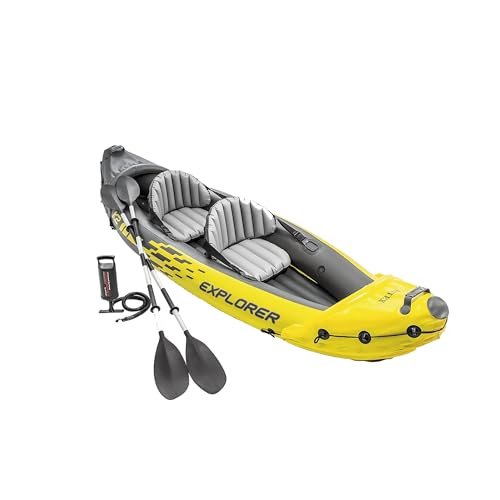Have you ever found a crack or hole in your kayak hull and wondered how to fix it quickly and effectively? A damaged hull can stop your adventure before it even begins, but repairing it doesn’t have to be complicated or expensive.
In this guide, you’ll discover simple, step-by-step methods to restore your kayak’s strength and keep it water-tight. Whether you’re a beginner or have some experience, these easy tips will help you get back on the water faster and with confidence.
Keep reading, because your kayak deserves the best care, and you deserve to enjoy every paddle without worry.

Assessing Hull Damage
Checking your kayak’s hull is important after every trip. Small cracks or holes can cause big problems if ignored.
This guide helps you find damage and decide what repairs are needed. Careful inspection keeps your kayak safe and seaworthy.
Identifying Common Hull Issues
Look for signs of wear and damage on your kayak’s hull. Some issues are easy to spot, others need a closer look.
- Cracks or splits in the surface
- Deep scratches or gouges
- Holes that let water in
- Delamination where layers separate
- Dents or deformations
Evaluating Damage Severity
Not all damage needs the same fix. Check how deep and wide the damage is to decide the repair method.
| Damage Type | Signs | Repair Needed |
|---|---|---|
| Minor scratches | Surface marks, no cracks | Light sanding and paint |
| Cracks | Visible splits, water leaks | Patch with resin and fiberglass |
| Holes | Open gaps, water entry | Fill with epoxy and fiberglass |
| Delamination | Bubbling or soft spots | Remove damaged layer, re-glue |
Preparing For Repair
Get your tools and materials ready before starting. Clean the damaged area well for a strong repair.
- Gather sandpaper, resin, fiberglass cloth
- Clean hull with soap and water
- Dry area completely before repair
- Protect surrounding parts with tape
- Work in a well-ventilated space

Gathering Repair Materials
Fixing a kayak hull needs the right materials for a strong repair. Gathering these items first makes the job easier and safer.
This guide covers the tools, adhesives, and safety gear needed to repair your kayak hull well.
Essential Tools And Supplies
Having the correct tools helps you work cleanly and quickly. Most supplies are easy to find at hardware stores or online.
- Sandpaper for smoothing damaged areas
- Plastic scraper or putty knife
- Clean cloths for wiping surfaces
- Mixing cups and stir sticks
- Masking tape to hold patches in place
- Heat gun or hair dryer (optional, for some repairs)
Choosing The Right Adhesives
Pick adhesives that bond well with kayak materials like plastic or fiberglass. Use strong, waterproof glues for lasting repairs.
| Adhesive Type | Best For | Dry Time |
| Epoxy Resin | Fiberglass and plastic | 4-6 hours |
| Marine Adhesive | Waterproof seals | 24 hours |
| Plastic Weld | Plastic kayaks | 1-2 hours |
Safety Equipment
Wear safety gear to protect yourself from dust and chemicals. Safety helps you work without harm.
- Protective gloves to avoid skin contact
- Safety goggles to shield your eyes
- Face mask or respirator for fumes and dust
- Work in a well-ventilated area
Preparing The Kayak Hull
Preparing the kayak hull is an important step before making any repairs. It helps the repair material stick well. This guide shows how to get the hull ready.
Start by cleaning, sanding, and masking the area. These steps make the repair last longer and look better.
Cleaning The Damaged Area
Remove dirt, grease, and old glue from the damaged area. Use mild soap and water to wash the surface. Dry it completely before moving on.
A clean surface helps the repair materials bond properly. Avoid using harsh chemicals that can damage the hull.
- Use a soft cloth or sponge with mild soap
- Rinse with clean water
- Let the area dry fully
- Do not use strong solvents
Sanding For Better Adhesion
Sanding roughens the hull surface around the damage. This helps the repair glue or resin stick better. Use fine-grit sandpaper for this task.
Sand gently and evenly. Avoid sanding too deep to prevent new damage. Clean off sanding dust before repair.
- Use 120 to 220 grit sandpaper
- Sand an area larger than the damage
- Remove all dust with a dry cloth
- Check for smooth but roughened surface
Masking Surrounding Surfaces
Protect the kayak around the repair area with masking tape. This keeps glue and resin off the clean hull. It also gives a neat repair edge.
Apply tape carefully. Cover all spots you want to stay clean. Remove tape after the repair dries.
- Use painter’s or masking tape
- Cover at least one inch beyond the repair area
- Press tape edges firmly to prevent leaks
- Remove tape slowly after repair cures
Step-by-step Repair Process
Repairing a kayak hull can save you money and extend your kayak’s life. This guide shows clear steps to fix cracks or holes.
Follow each step carefully to make your kayak strong and waterproof again. Use the right tools and materials for the best results.
Applying Patch Or Resin
Clean the damaged area well. Remove dirt, grease, or loose pieces before starting.
Apply a thin layer of resin over the crack or hole. This helps the patch stick better and seals the surface.
- Sand the area around the damage lightly
- Wipe with a clean cloth
- Mix resin according to instructions
- Use a brush to spread resin evenly
Layering Fiberglass Cloth
Cut fiberglass cloth to cover the damaged area with some extra space. You may need several layers for strength.
Place the cloth on the resin-coated area. Then add more resin over the cloth to soak it fully.
- Use scissors to cut the cloth slightly larger than damage
- Lay the first cloth layer on wet resin
- Brush resin over the cloth to saturate it
- Repeat for additional layers if needed
Smoothing And Shaping
Let the resin dry completely. This can take several hours depending on the temperature.
Sand the repaired area smooth. Shape it to match the kayak hull for better water flow.
- Use fine-grit sandpaper for smoothing
- Check for bumps or rough spots
- Remove dust with a clean cloth
- Apply a finishing coat of resin if needed
Curing And Finishing Touches
After fixing your kayak hull, it is important to cure and finish the repair properly. This process strengthens the patch and protects your kayak from water damage.
Follow the right steps to ensure your repair lasts and looks smooth. The key parts are drying, sanding, and sealing the surface.
Allowing Proper Drying Time
Let the repair dry fully before moving to the next step. Drying time depends on the material and weather conditions. Rushing this step can weaken the patch.
- Keep the kayak in a warm, dry place.
- Avoid touching or moving the repair area.
- Check the product instructions for exact drying time.
- Use a fan or dehumidifier to speed up drying if needed.
Sanding For A Smooth Finish
After drying, sand the repair area to make it smooth. This helps the paint stick better and improves the kayak’s look.
| Sandpaper Grit | Use |
|---|---|
| 80-120 | Initial sanding to shape the patch |
| 220-320 | Fine sanding for a smooth surface |
| 400+ | Final sanding before painting |
Painting And Sealing
Paint and seal the repaired area to protect it from water and sun damage. This step also restores the kayak’s appearance.
- Choose paint made for marine use or plastic surfaces.
- Apply thin, even coats and let each dry fully.
- Use a clear sealant to add extra protection.
- Allow the sealant to cure as per instructions before use.
Maintenance Tips For Longevity
Taking care of your kayak ensures it lasts for many adventures. Regular checks and repairs prevent big problems. Here are simple ways to keep your kayak in great shape.
Learn how to inspect, protect, and store your kayak properly. Follow these tips to enjoy smooth paddling experiences for years.
Regular Inspections
Check your kayak for cracks and dents often. Look for any signs of wear and tear. Fix small issues before they get worse.
Inspect the hull, seams, and fittings. Ensure all parts are in good condition. This prevents accidents during use.
- Examine the hull for scratches or holes
- Check seams for any splits
- Ensure fittings are tight and secure
Preventing Future Damage
Protect your kayak from sharp objects and rough surfaces. Use a kayak cover when not in use. Avoid dragging it on the ground.
Consider using pads or straps for transportation. This minimizes stress on the hull. Be careful when launching or landing.
- Use a cover to shield from sun and rain
- Lift the kayak instead of dragging it
- Secure with pads during transport
Storage Best Practices
Store your kayak in a cool, dry place. Keep it out of direct sunlight. Position it on a rack or hang it to avoid pressure points.
Ensure proper ventilation around the kayak. This prevents mold and mildew. Regularly check the storage area for pests.
- Keep the kayak indoors or under a shade
- Use a rack to distribute weight evenly
- Check the storage area for moisture

Frequently Asked Questions
How Do I Identify Kayak Hull Damage?
Inspect your kayak for cracks, holes, or deep scratches. Check both inside and outside the hull. Look for soft spots or water leaks. These signs indicate damage needing repair to prevent water entry and maintain kayak performance.
What Materials Are Best For Kayak Hull Repair?
Use marine-grade epoxy resin or polyester resin for durable repairs. Fiberglass cloth strengthens the patch area. For plastic kayaks, use plastic welding kits or specialized adhesives. Always choose materials compatible with your kayak’s hull type.
Can I Repair A Kayak Hull Myself?
Yes, many kayak hull repairs are DIY-friendly. With the right tools and materials, you can fix small cracks or holes. Follow detailed steps carefully. For extensive damage, consider professional help to ensure safety and durability.
How Long Does Kayak Hull Repair Take?
Small repairs usually take a few hours, including curing time. Larger repairs may take a day or more to complete. Always allow the resin or adhesive to fully dry before using the kayak again.
Conclusion
Repairing a kayak hull is simple with the right steps. Small cracks and holes should not stop your adventure. Clean the area well before applying patches or resin. Let the repair dry fully to ensure strength. Regular checks help catch damage early and keep your kayak safe.
Taking care of your kayak means more fun on the water. Keep practicing these repairs to save time and money. Your kayak will stay strong and ready for many trips ahead.



